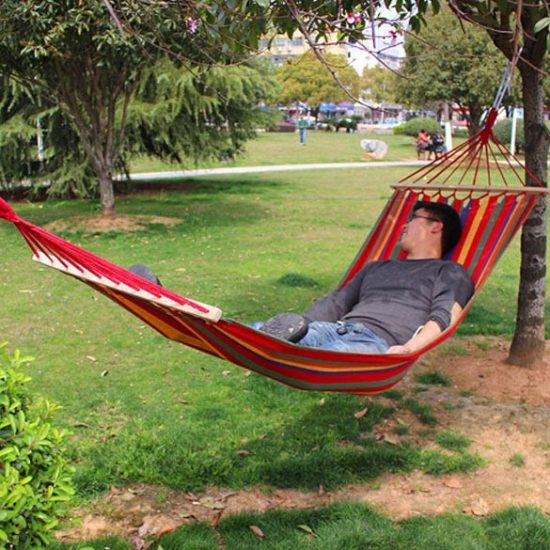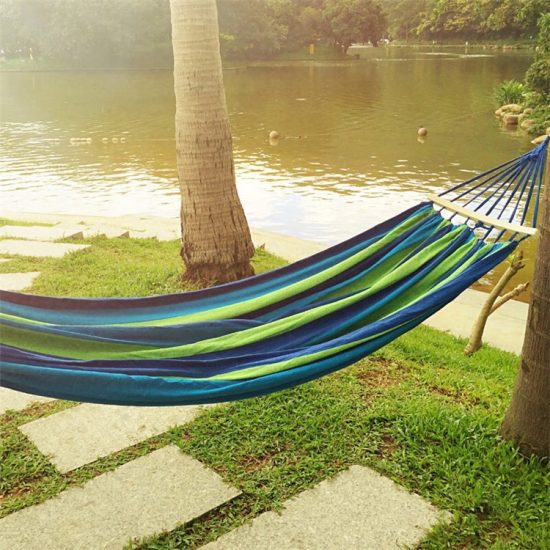Camping hammocks have become increasingly popular among outdoor enthusiasts due to their lightweight, portable, and comfortable nature. Whether you’re a beginner or an experienced camper, here’s the ultimate guide to camping hammocks to help you make the most of your outdoor adventures.
- Choosing the Right Hammock:
- Size and Capacity: Consider the length and width of the hammock to ensure it accommodates your height and weight comfortably.
- Material: Look for durable, lightweight, and breathable materials like nylon or polyester. These materials are quick-drying and resistant to mildew and mold.
- Weight and Portability: Opt for a hammock that is lightweight and easily packable, especially if you plan to carry it on backpacking trips.
- Suspension System: Check if the hammock comes with a suspension system or if you need to purchase it separately. Adjustable straps with tree-friendly attachments are a great option.
- Hammock Accessories:
- Rainfly or Tarp: Protect yourself from rain and provide shade by using a rainfly or tarp. Ensure it’s large enough to cover the entire hammock and set it up with proper tension to prevent water pooling.
- Bug Net: If you’re camping in bug-prone areas, a bug net will keep mosquitoes and other insects at bay, providing a comfortable and peaceful sleep.
- Underquilt or Sleeping Pad: To insulate your hammock from the cold air beneath, use an underquilt or a sleeping pad. This helps retain body heat and provides extra comfort.
- Gear Stash: Consider a gear stash, which is a small pouch or organizer attached to the ridgeline of the hammock. It keeps essentials like a headlamp, phone, or water bottle within reach.
- Setting Up Your Hammock:
- Location: Find sturdy trees or anchor points that are the appropriate distance apart (12-15 feet) for hanging your hammock. Avoid dead or weak branches.
- Suspension: Use tree-friendly straps and follow the instructions provided by the manufacturer. Wrap the straps around the trees and attach the hammock to the straps using carabiners or other attachment mechanisms.
- Angle and Sag: Hang your hammock with a slight downward sag to achieve a comfortable lying position. A 30-degree angle from the ground is a good starting point.
- Stability and Balance: Test the stability and balance of the hammock before getting in. Make adjustments to the suspension or positioning if needed.
- Hammock Etiquette and Safety:
- Leave No Trace: Practice Leave No Trace principles by respecting the environment and minimizing your impact. Avoid damaging trees and vegetation while setting up your hammock.
- Weight Limit: Follow the weight limit specified by the manufacturer to ensure your safety and the longevity of the hammock.
- Inspect the Gear: Before each use, inspect your hammock, suspension system, and accessories for any signs of wear or damage. Replace or repair any compromised components.
- Weather Conditions: Be mindful of the weather conditions. Avoid setting up your hammock under dead branches, in areas prone to flooding, or during severe weather conditions.
- Hammock Comfort and Sleep:
- Proper Positioning: Lie diagonally in your hammock for a flatter and more comfortable sleeping position. This reduces the risk of back discomfort and creates a more stable sleep surface.
- Adjustments: Make adjustments to the tension and sag of your hammock until you find the most comfortable position for you.
- Additional Support: Use a pillow or stuff your clothes into a sack to create a makeshift pillow. This provides neck support and enhances overall comfort.
- Stay Warm: Use appropriate insulation like an underquilt, sleeping pad, or a sleeping bag to stay


